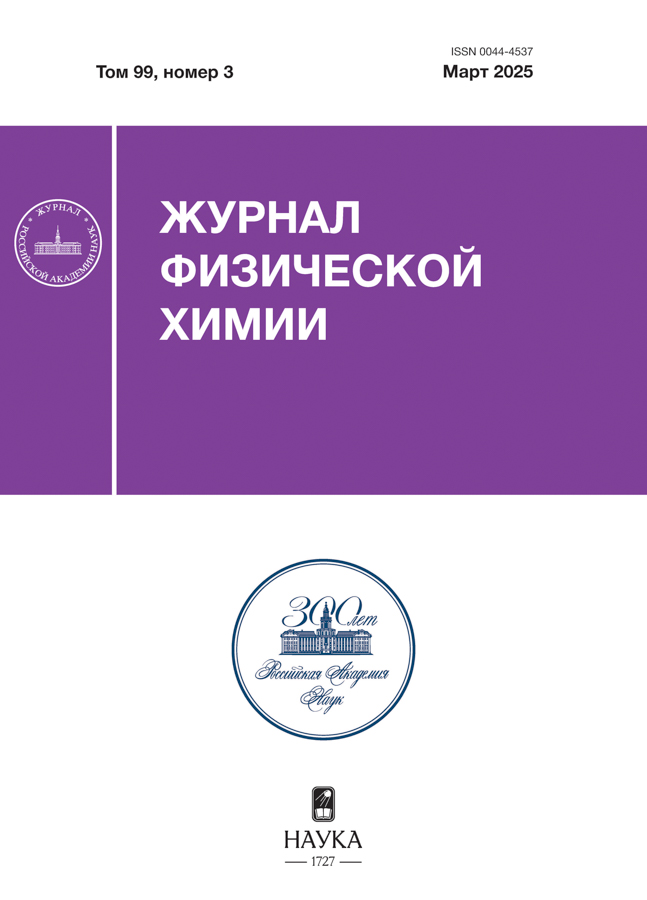Heat capacity of magnesium-neodymium hexaaluminate NdMgAl₁₁O₁₉
- Authors: Gagarin P.G.1, Guskov A.V.1, Guskov V.N.1, Ryumin M.A.1, Nikiforova G.E.1, Gavrichev K.S.1
-
Affiliations:
- N. S. Kurnakov Institute of General and Inorganic Chemistry, Russian Academy of Sciences
- Issue: Vol 99, No 3 (2025)
- Pages: 384–391
- Section: ХИМИЧЕСКАЯ ТЕРМОДИНАМИКА И ТЕРМОХИМИЯ
- Submitted: 03.06.2025
- Published: 29.05.2025
- URL: https://permmedjournal.ru/0044-4537/article/view/682011
- DOI: https://doi.org/10.31857/S0044453725030028
- EDN: https://elibrary.ru/EBKXGW
- ID: 682011
Cite item
Abstract
Heat capacity of magnesium-neodymium hexaaluminate NdMgAl11O19 with the magnetoplumbite structure is measured by relaxation, adiabatic, and differential scanning calorimetry in the temperature range 2-1850 K. Smoothing of the data is carried out after matching the temperature dependences of the heat capacity obtained by different methods. Thermodynamic functions (entropy and enthalpy change) are calculated, and the anomalous Schottky heat capacity in the low temperature region is estimated.
Keywords
Full Text
About the authors
P. G. Gagarin
N. S. Kurnakov Institute of General and Inorganic Chemistry, Russian Academy of Sciences
Author for correspondence.
Email: gagarin@igic.ras.ru
Russian Federation, Moscow, 119991
A. V. Guskov
N. S. Kurnakov Institute of General and Inorganic Chemistry, Russian Academy of Sciences
Email: gagarin@igic.ras.ru
Russian Federation, Moscow, 119991
V. N. Guskov
N. S. Kurnakov Institute of General and Inorganic Chemistry, Russian Academy of Sciences
Email: gagarin@igic.ras.ru
Russian Federation, Moscow, 119991
M. A. Ryumin
N. S. Kurnakov Institute of General and Inorganic Chemistry, Russian Academy of Sciences
Email: gagarin@igic.ras.ru
Russian Federation, Moscow, 119991
G. E. Nikiforova
N. S. Kurnakov Institute of General and Inorganic Chemistry, Russian Academy of Sciences
Email: gagarin@igic.ras.ru
Russian Federation, Moscow, 119991
K. S. Gavrichev
N. S. Kurnakov Institute of General and Inorganic Chemistry, Russian Academy of Sciences
Email: gagarin@igic.ras.ru
Russian Federation, Moscow, 119991
References
- Lu H., Wang C.-A., Zhang C. // Ceram. Int. 2014. V. 40. P. 16273. https://doi.org/10.1016/j.ceramint.2014.07.064
- Chen X., Sun Y., Hu J., et al. // J. Europ. Ceram. Soc. 2020. V. 40. P. 1424. https://doi.org/10.1016/j.jeurceramsoc.2019.12.039
- Gadow R., Lischka M. // Surf. Coat. Tech. 2002. V. 151–152. P. 392. https://doi.org/10.1016/S0257-8972(01)01642-5
- Chen X., Gu L., Zou B., et al. // Surf. Coat. Tech. 2012. V. 206. P. 2265. doi: 10.1016/j.surfcoat.2011.09.076
- Gagarin P.G., Guskov A.V., Guskov V.N. et al. // Russ. J. Inorg. Chem. 2023. V. 68. P. 1460. https://doi.org/10.1134/S0036023623601861 [Гагарин П.Г., Гуськов А.В., Гуськов В.Н. и др. // Журн. неорган. химии. 2023. Т. 68. № 10. С. 1462.]
- Min X., Fang M., Huang Z. et al. // Opt. Mat. 2014. V. 37. P. 110. http://dx.doi.org/10.1016/j.optmat.2014.05.008
- Wang Y.-H., Ouyang J.-H., Liu Z.-G. // J. Alloys Comp. 2009. V. 485. P. 734. doi: 10.1016/j.jallcom.2009.06.068
- Lu H., Wang C.-A., Zhang C., et al. // J. Europ. Ceram. Soc. 2015. V. 35. P. 1297. http://dx.doi.org/10.1016/j.jeurceramsoc.2014.10.030
- Westrum E.F., Burriel R., Jr., Gruber J.B., et al. // J. Chem. Phys. 1989. V. 91. P. 4838. https://doi.org/10.1063/1.456722
- Tari A. The Specific Heat of Matter at Low Temperatures, Imperial College Press, 2003. 250 p.
- Gruber J.B., Justice B.H., Westrum E.F., Zandi B., Jr. // J. Chem. Thermodyn. 2002. V. 34. P. 457. doi: 10.1006/jcht.2001.0860
- Gruber J.B., Zandi B., Justice B.H., Westrum E.F., Jr. // J. Phys. and Chem. 2000. V. 61. P. 1189. https://doi.org/10.1021/j100726a052
- Bansal N.P., Zhu D. // Surf. Coat. Tech. 2008. V. 202. № 12. P. 2698. https://doi.org/10.1016/j.surfcoat.2007.09.048
- Shi Q., Snow C.L., Boerio-Goates J., Woodfield B.F. // J. Chem. Thermodyn. 2010. V. 42. P. 1107. doi: 10.1016/j.jct.2010.04.008
- Shi Q., Boerio-Goates J., Woodfield B.F. // J. Chem. Thermodyn. 2011. V. 43. P. 1263. doi: 10.1016/j.jct.2011.03.018
- Ryumin M.A., Nikiforova G.E., Tyurin A.V., et al. // Inorgan. Mater. 2020. V. 56. № 1. P. 97. doi: 10.1134/S0020168520010148 [Рюмин М.А., Никифорова Г.Е., Тюринидр А.В. // Неорган. материалы. 2020. Т. 56. № 1. С. 102. doi: 10.31857/S0002337X20010145]
- Малышев В.В., Мильнер Г.А., Соркин Е.Л., Шибакин В.Ф. // Приб. техн. эксп. 1985. Т. 6. С. 195.
- Furukawa G.T., McCoskey R.E., King G.J. // J. Res. Natl. Bur. Stand. 1951. V. 18. № 4. P. 256.
- Ditmars D.A., Ishihara S., Chang S.S., et al. // J. Res. Natl. Bur. Stand. 1982. V.87. № 2. P. 159. doi: 10.6028/jres.087.012
- Gagarin P.G., Guskov A.V., Guskov V.N. et al. // Rus. J. Inorg. Chem. 2023. V. 68. № 11. P. 1599. doi: 10.1134/S0036023623602064 [Гагарин П.Г., Гуськов А.В., Гуськов В.Н. и др. // Журн. неорган. химии. 2023. Т. 68. № 11. С. 1607. doi: 10.31857/S0044457X23601062]
- Prohaska T., Irrgeher J., Benefield J., et al. // Pure Appl. Chem. 2022. V. 94 (5). P. 573. https://doi.org/10.1515/pac-2019-0603
- Voskov A.L., Kutsenok I.B., Voronin G.F. // Calphad. 2018. V. 16. P. 50. https://doi.org/10.1016/j.calphad.2018.02.001
- Voronin G.F., Kutsenok I.B. // J. Chem. Eng. Data. 2013. V. 58. P. 2083. https://doi.org/10.1021/je400316m
- Восков А.Л. // Журн. физ. химии. 2022. Т. 96. № 9. С. 1296. doi: 10.31857/S0044453722090308 [Voskov A.L. // Russ. J. Phys. Chem. 2022. V. 96. P. 1895. https://doi.org/10.1134/S0036024422090291]
- Popa K., Jutier F., Wastin F., Konings R.J.M. // J. Chem. Thermodyn. 2006. V. 38. P. 1306–1311. doi: 10.1016/j.jct.2006.02.006
- Maier C.G., Kelley K.K.// J. Am. Chem. Soc. 1932. V 54. P. 3243–3246. doi: 10.1021/ja01347a029
- Kowalski P.M., Beridze G., Vinograd V.L., Bosbach D. // J. Nucl. Mater. 2015. V. 464. P. 147. https://doi.org/10.1016/j.jnucmat.2015.04.032
- Thiriet C., Konings R.J.M., Javorsky P., et al. // J. Chem. Thermodyn. 2005. V. 37. P. 131. doi: 10.1016/j.jct.2004.07.031
Supplementary files















